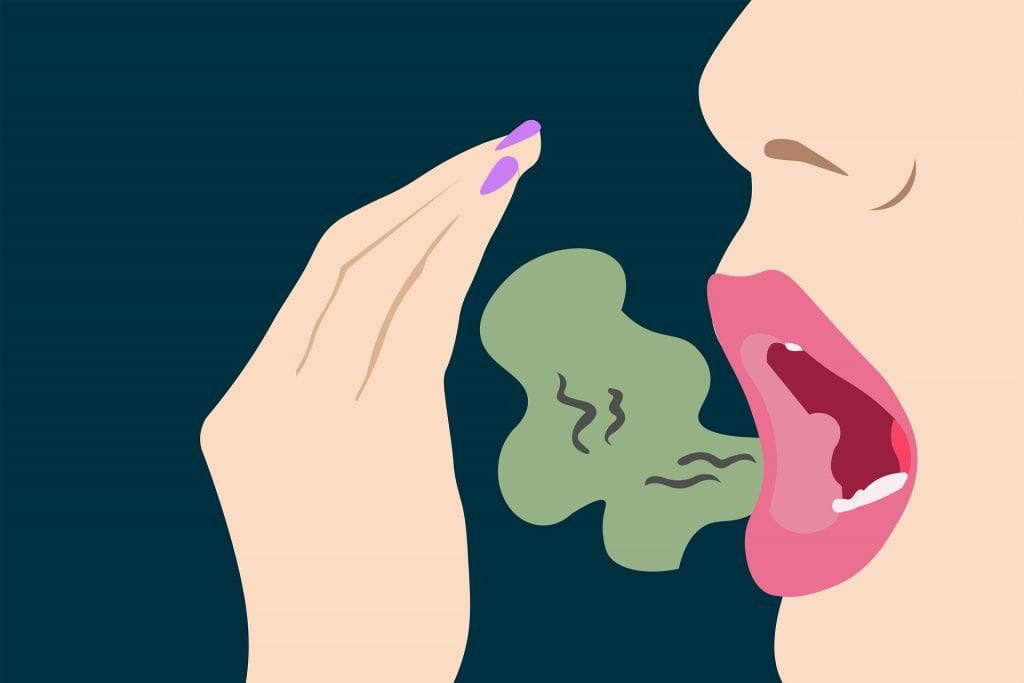Guest blog by Designs for Sports
Not much can ruin a pleasant conversation more than bad breath particularly when it’s taking place within tight confines such as an office or car.
Oral malodor is often much more than a superficial offense requiring peppermints or toothpaste. It can be an indication that disease and abnormalities lurk within the body. In fact, chronic halitosis is a frequently overlooked sign of deeper complications including gut dysbiosis toxin overload and acidosis.
Gut Dysbiosis
Halitosis almost always accompanies gut dysbiosis as the methane and hydrogen gases produced by copious amounts of anaerobic bacteria and yeast make their way to the lungs and oral cavity. Strangely many people do not associate bad breath with their internal gut environment. Yet hydrogen and methane breath tests have been used for years to evaluate the bacterial environment of the gut. Bacterial overgrowth in the bowels is often associated with a diet rich in simple carbohydrates since these microorganisms thrive on these food sources. Abundant amounts of bacteria and yeast trigger cravings for carbs and as the individual indulges they subsequently experience a worsening of bad breath. The anaerobic fermentation of the simple sugars/carbs by the microorganisms proportionally increases methane gases in the breath. While peppermint flavoring may mask the offensive gases the sugars found in many breath mints and gums, ironically will exacerbate the problem.
Gut dysbiosis always includes some degree of Candida overgrowth alongside various species of pathogenic bacteria. Candida however is adept at creeping into various regions of the gut and eventually finds its way to the oral cavity where it creates a foul-smelling coating on the tongue. Studies have confirmed that tongue-coating due to Candida is a source of volatile sulfur compounds causing bad breath.
Unresolved and progressive gut dysbiosis often leads to compromised digestion and malabsorption of food and nutrients. Lingering food particles cause a prolonged period of fermentation and provide an ideal setting for continued bacterial/yeast growth leading to chronic halitosis and an equally smelly stool. When gut dysbiosis is the root of bad breath, a comprehensive dismantling of the gut environment is crucial. Employing the use of antimicrobials probiotics glutamine and a low carbohydrate diet is essential for improving both breath and health of the individual.
Toxin Overloads
Bad breath can also be a sign of toxin overload and a compromised detoxification system. Failure of any detoxification mechanism including the liver kidneys or intestines can increase smelly gases in the breath. Gut dysbiosis is a root cause of a toxic gut since elimination is often compromised and irregular. Recent studies have also found that liver conditions such as hepatitis B and cirrhosis, produce unique measurable breath gases as a result of diminished detoxification ability. Likewise, kidney disease will yield increased levels of volatile sulfur compounds in the breath. When bad breath is accompanied by an ammonia odor of sweat and urine, kidney function should be investigated as the root issue. As we live in an increasingly toxic world it is vital that the primary detoxification mechanisms are functioning optimally. Stinky breath is just one indicator that the toxic load in the body is mounting and our detoxification systems may need support.
Acidosis
A final issue associated with chronic halitosis is mild systemic acidosis. While breath tests have been standard tools for measuring ketones in diabetics and for diagnosing metabolic acidosis, chronic halitosis isn’t often considered a standard indication of subclinical acidosis. Perhaps it should be. Subclinical acidosis is often self-induced by a diet high in animal protein salt and sugar and low in fruits and vegetables. This state of acidosis not only creates an ideal environment for microbial growth (leading to gut dysbiosis) but can also stress the kidneys and liver, subsequently increasing the toxic burden. Additionally, mild acidosis increases the risks of periodontal disease the leading cause of halitosis.
Chronically bad breath does not always require another trip to the dentist nor does it call for more Tic Tacs. Instead, it should be a warning sign of underlying health complications that not only rob individuals of their social life but also of their core health.

